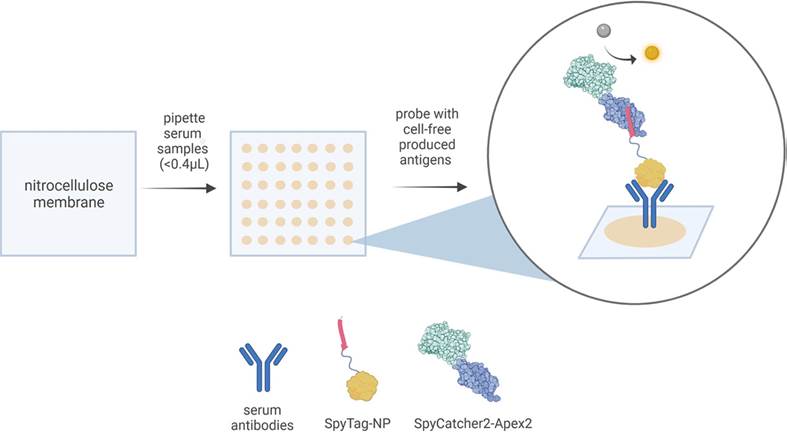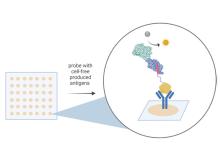BACKGROUND
The COVID-19 pandemic has underscored the need for adaptable, affordable, and accessible diagnostic platforms, especially in low-resource settings. Traditional diagnostic methods like ELISAs, CLIAs, and LFAs require costly or sophisticated reagents, which can be challenging to acquire during outbreaks. Cell-free synthetic biology offers a promising solution by enabling rapid, on-demand production of functional biologics, such as viral antigens and therapeutic antibodies, using basic laboratory infrastructure.
TECHNOLOGY
The Cell-Free Dot Blot (CFDB) method is a novel immunoassay platform designed for rapid and cost-effective detection of antibodies (Figure 1). It utilizes linear DNA to produce target viral antigens fused to a SpyTag peptide in a cell-free expression system, eliminating the need for traditional cloning and antigen purification. The CFDB method employs SpyCatcher2-Apex2, an E. coli-produced peroxidase conjugate, as a universal secondary detection reagent. Sera are spotted directly on a nitrocellulose membrane, enabling a simple dipping mechanism for downstream incubation and washing steps.

Figure 1. Cell free dot blot for detection of antibodies. Serum samples are spotted on a nitrocellulose membrane. A cell-free expression system is used to produce a target viral antigen fused to a SpyTag peptide (SpyTag-NP) which can be used to detect target antibodies using SpyCatcher2-Apex2 through a peroxidase-based readout.
COMPETITIVE ADVANTAGE
- Cost-Effective: One CFDB assay costs approximately $3 USD, compared to over $300 USD for a 96-well ELISA kit.
- Rapid Production: Viral antigens can be synthesized on-demand in just 2 days.
- Accessibility: Operable using basic laboratory infrastructure, similar to Western blotting experiments.
- Versatility: Easily adaptable for other infectious diseases by changing the gene encoding the antigen of interest.
- Comparable Performance: Demonstrated sensitivity and specificity comparable to conventional ELISAs.
APPLICATIONS
- Pandemic Response: Mass immunity screening for COVID-19 and future pandemics.
- Veterinary Immunology: Detection of antibodies in animal populations.
- Public Health: Informing government policies on pandemic response.
- Vaccine Development: Assessing antibody responses in vaccine efficacy studies.
INTELLECTUAL PROPERTY STATUS
- PCT application (Jan 2024)
PROJECT STATUS
The CFDB method has been validated through independent testing at collaborating laboratories, demonstrating its effectiveness in detecting anti-SARS-CoV-2 antibodies in human and animal sera.
KEYWORDS
Cell-free dot blot, COVID-19, synthetic biology, viral antigens, immunoassays, immunodiagnostics, infectious disease, pandemic response, public health, veterinary immunology.





